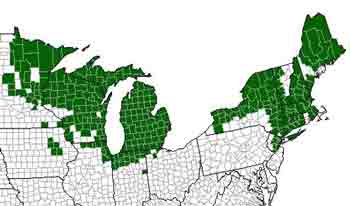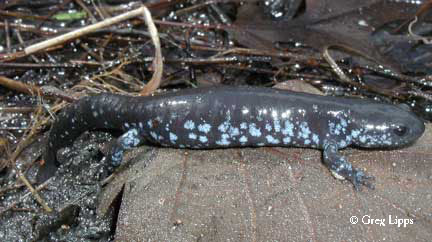
Blue-spotted Salamander
(Ambystoma laterale)
 |
 |
|
|
Distribution of the Blue-spotted Salamander (from the AR MI Atlas)
|
An adult Blue-spotted Salamander
|
|
Description: Relatively small and slender member of the genus, usually not exceeding 5 ½” in length. It gets its name from the blue or whitish flecks and blotches along the sides of its body. The dorsum is a dark gray to grayish black, while the venter is sometimes brownish gray with light speckling. As this species is a contributing member in Ohio’s unisexual salamander complexes, it is nearly impossible to positively identify without the use of molecular evidence. In northwestern Ohio, male salamanders (identified by their swollen cloaca during the breeding season) matching the above description are most probably Blue-spotted Salamanders. |
||
Distribution in Ohio: Positively identified only in Williams, Henry and Lucas counties in northwestern Ohio. |
||
|
|
||
Status in Ohio: The Ohio Division of Wildlife lists the Blue-spotted Salamander as ENDANGERED. |
||
|
|
||
Habitat: Unlike other members of the genus, Blue-spotted Salamanders will often utilize more open breeding sites, such as wet prairies. Outside of the breeding season they live in damp forested areas, in burrows and under rotting logs. The Blue-spotted Salamander appears to be limited to areas of sandy soils, such as those found in the Oak Openings Region of northwestern Ohio. |
||
|
|
||
Life history: Nighttime breeding migrations to vernal pools usually occur during or after rainfall from mid-March to mid-April. Courtship, mating, and egg-laying all occur underwater. Eggs are attached singly or in small clusters to leaves, twigs, or scattered along the pond bottom. The larvae hatch 3-4 weeks later and feed on aquatic invertebrates until metamorphosis 8-12 weeks later. |
||
|
|
||
Conservation: The Blue-spotted Salamander relies on vernal pools for breeding and adjacent forested habitat for their adult life. Threats to this species include wetland filling and draining, introduction of fish to breeding ponds, pollutants, such as insecticides and herbicides, and loss of adult habitat. |
||
Last modified:
|
Ohio Amphibians · Ohio Salamander Web · Ohio Salamander Species · Amphibian Habitats · Salamander Monitoring |
|